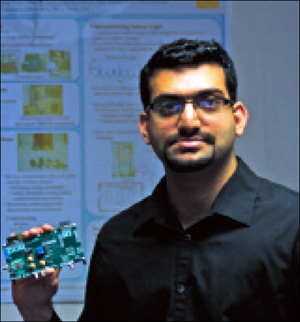Typically, Passive ultrahigh-frequency RFID transponders transmit a unique serial number and perhaps some text information to readers. But Stewart Thomas, a research scientist in Duke University‘s electrical and computer engineering department, has proved they can do a whole lot more. Passive tags can transmit sound and video recordings, which could open the way for new implantable medical device applications.
While Thomas was studying to be an RF engineer, working on his Ph.D. at Duke under the guidance of Matthew Reynolds, he began to wonder if sound and moving images could be sent via the backscatter technique used by passive UHF systems. He got a chance to find out when he connected with Anthony Leonardo, a researcher at Howard Hughes Medical Center, who studies the neural basis of animal behavior. Leonardo was looking for a way to transmit data from a dragonfly in flight, but battery-powered transmitters were too heavy for the insect to fly normally.
Working with Reid Harrison, founder of Intan Technologies, which makes microchips that sense the weak electronic signals produced by biological systems, the researchers created an RFID transponder that could be attached to the back of a dragonfly. They attached sensors to the insect’s body to capture neural signals, and the information from those signals was transmitted in real time via the custom RFID chip, which can communicate with a reader at 5 megabits per second (conventional UHF RFID systems transmit at 640 kilobits per second). “As the dragonfly flew around, we were able to capture its neural signals in real time using passive backscatter communication,” Thomas says.
Thomas then used the same passive backscatter technique to stream audio recorded on an iPod and video from a slow-scan television. This approach has enormous potential in the medical field. Passive tags could help remotely monitor the movements and vital signs of the sick or elderly. Rich data could be sent from implants monitoring a patient’s heart, brain or other organs—and because the tags don’t require batteries, the implants would be relatively small and less invasive than other tags. “This kind of system could be used to capture information about the movement of animal or human muscles simply by using a patch placed on the skin,” Thomas says.
The system used a special chip and air-interface protocol, but Thomas believes ordinary passive RFID systems could eventually be used to transmit neural signals as well as audio and video. “There’s no fundamental difference between the tags and readers we are building and existing passive UHF RFID systems,” he says. “The big challenge with sending a lot of data via existing RFID systems is making sure you get power to the tag constantly. Since the tag has no battery and only the means to store a small amount of energy for short periods, you’d need to keep the tag powered to capture continuous data from a patch on the skin.”


